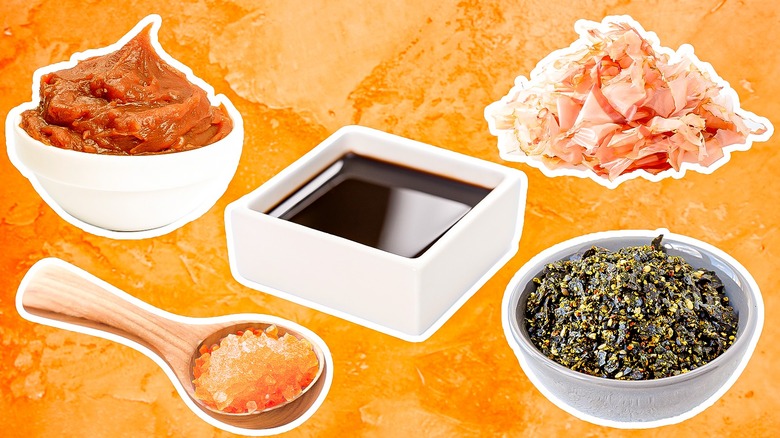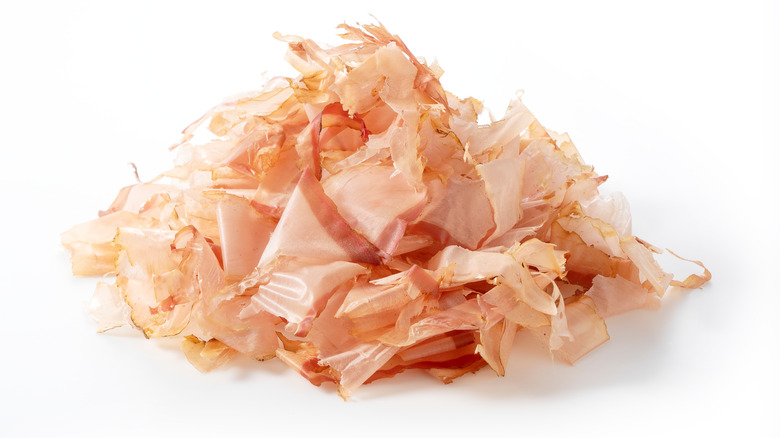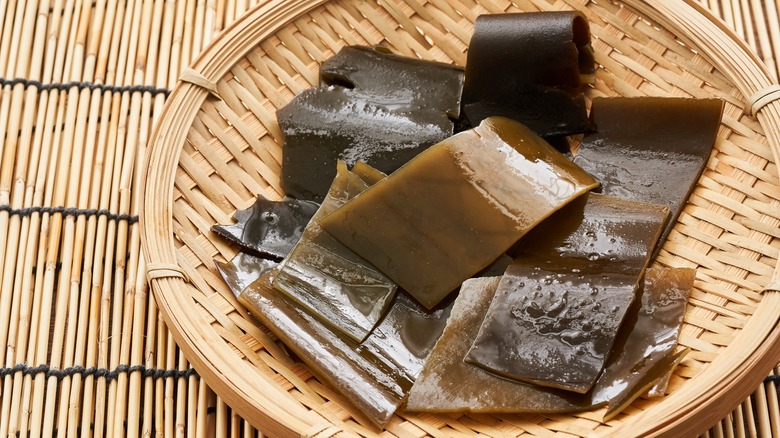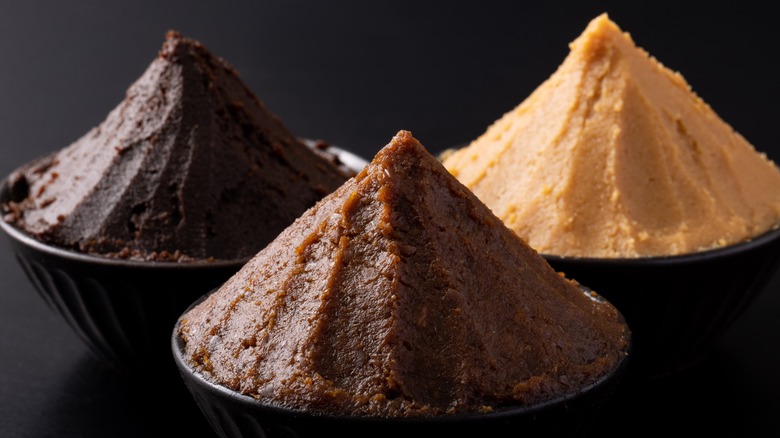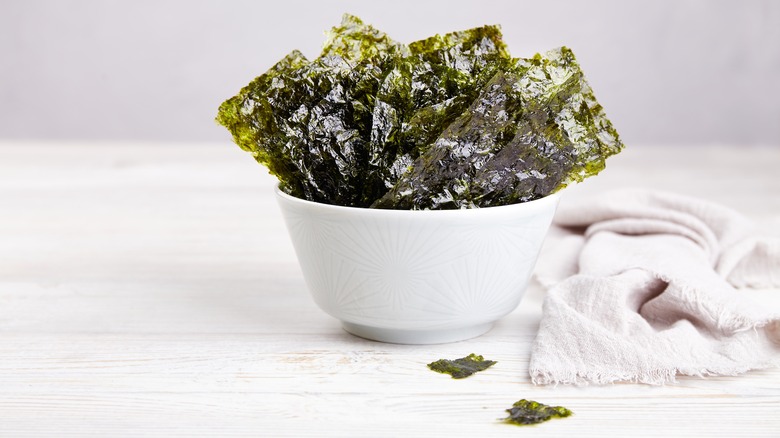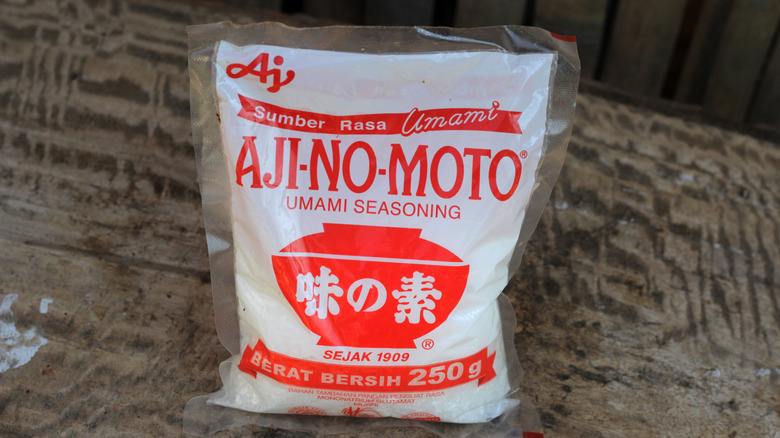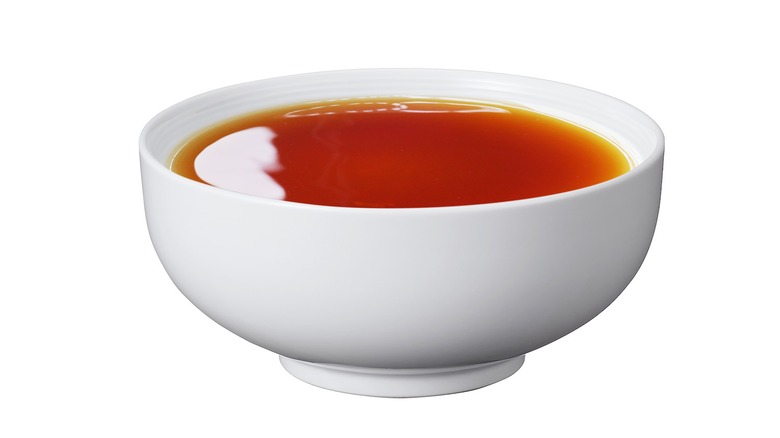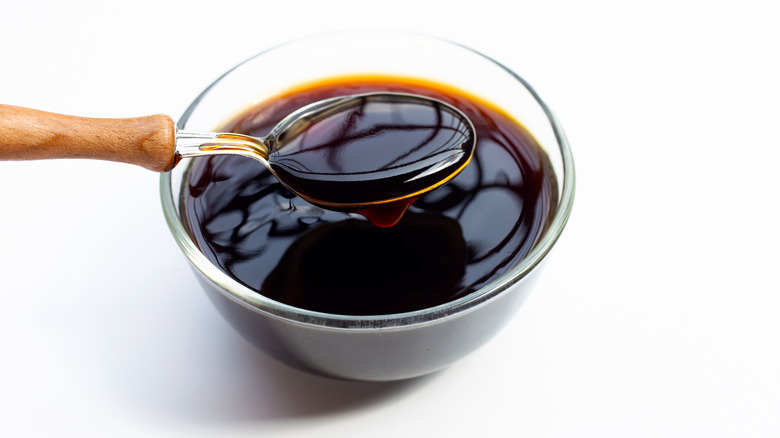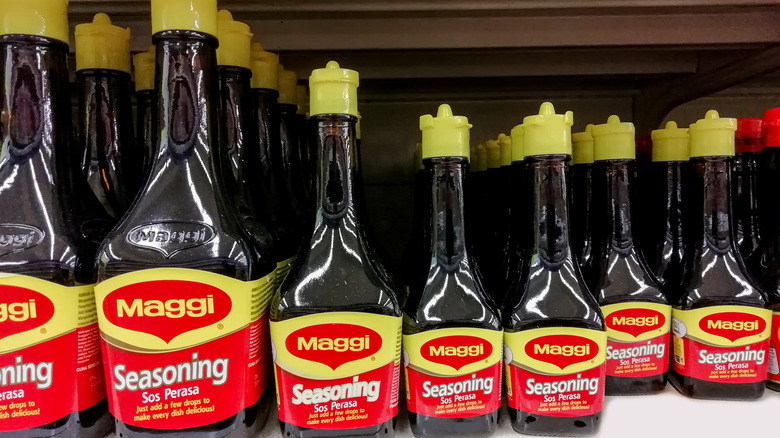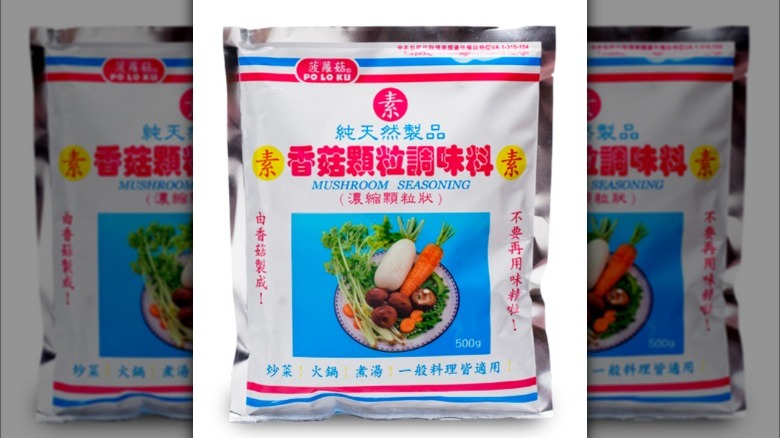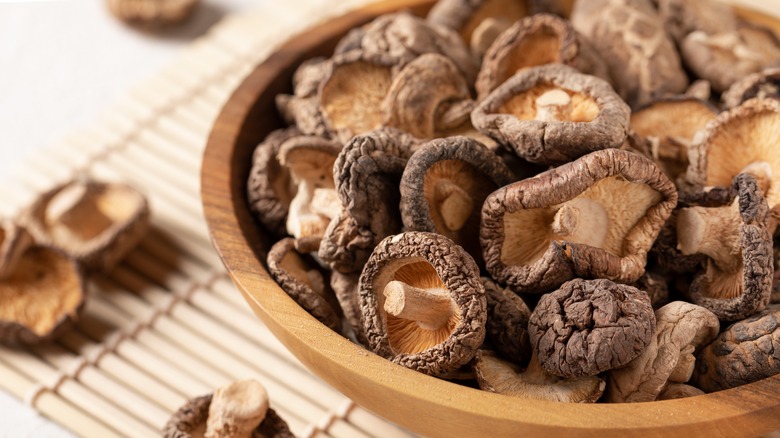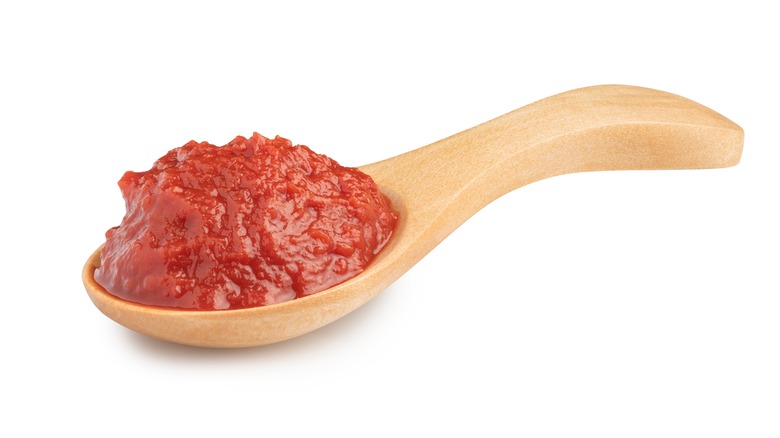14 Umami-Rich Ingredients You Should Always Have In Your Pantry
Umami is called "the fifth taste" because it was discovered after the other four basic tastes your taste buds can perceive: sour, salty, bitter, and sweet. The name "umami" is a Japanese term that roughly translates to "delicious," but the actual flavor of umami is hard to describe in words. Perhaps the closest English adjective is "savory," though "meaty" is pretty close too. Being aware of which ingredients to use to increase the umami flavor in your dishes will make you a better cook and make your food more, well, delicious.
Any home cook knows which ingredients are rich in the other four basic tastes — salt is salty, sugar is sweet, vinegar is sour, etc. But what should you reach for when a dish requires more savory deliciousness? Fortunately, there are many umami-rich ingredients you can stock in your pantry. Here are some of our favorite ingredients that will take your recipes to a new level of meaty intensity.
1. Bonito flakes
You might not be able to tell from looking at them, but bonito flakes start as a type of fish: skipjack tuna. The tuna is smoked, dried, then left to cure in the sun with a coating of a specific type of mold. The process turns the fish rock-hard and makes it into an umami bomb. To turn the bonito into flakes, the hardened fish is shaved paper-thin.
The reason bonito flakes pack such an umami punch is their high levels of inosinate, which has a savory taste. Even better, inosinate works together with another umami substance, glutamate, to create an intense sensation of savoriness. Japanese cuisine uses this inosinate-glutamate combo extensively; it's what makes dashi broth so delicious. Dashi, which is usually made with a mixture of bonito flakes and dried kelp (kombu, which provides the glutamates), is the base for many iconic Japanese dishes like miso soup.
Making broth is just one way to utilize bonito flakes. Due to their light, airy texture, they move around almost like they're alive when used as a garnish on hot food. The fish flakes make for a delicious and visually-spectacular topping on Japanese street food dishes, or anything else that could use a smoky, salty finish.
2. Kombu
We can't talk about bonito flakes without mentioning their dashi partner, kombu. This ingredient is made from various species of kelp which are harvested from the ocean and then dried. Kombu is actually responsible for the discovery of umami. In the early 20th century, Dr. Kikunae Ikeda became determined to figure out what made kombu broth so savory and delicious. He figured out that the glutamic acid in kombu contributed a delicious flavor that hadn't yet been named. He dubbed the newly-discovered taste "umami."
While kombu makes an irresistibly umami-rich base for soups, that's only one application for this special seaweed. Boiled kombu can also be sliced thin and used in salads. Alternatively, kombu can be turned into a seasoning powder by toasting and grinding it.
Kombu is also a worthwhile pantry staple because it has many health benefits in addition to its umami properties. It contains an enzyme that helps makes beans more digestible and is a source of multiple vitamins and minerals, including the essential nutrient iodine, according to UMass Chan Medical School.
3. Soy sauce
Soy sauce's rich, complex umami flavor can be attributed to the fermentation process used to manufacture it. Traditional soy sauce-making is a time-consuming labor of love. First, soybeans and wheat are cooked and then inoculated with koji mold. The moldy soy and wheat are then blended with salt water and left to ferment for a period of months. A combination of enzymes from the mold, bacteria, and yeast all contribute to the fermentation, creating the umami taste that soy sauce is known for.
Soy sauce is great in innumerable recipes. It's of course the critical seasoning in many Asian dishes, and it can also add a savory kick to soups, stews, barbecue sauce, and more. If you want a soy sauce substitute that's not made with wheat, look for tamari, which is typically gluten-free.
Mushroom soy sauce is another variety that might be worth stocking in your pantry. It's usually made with molasses-enriched dark soy sauce flavored with straw mushrooms. The mushroom essence adds extra umami while the molasses contributes a touch of sweetness.
4. Miso
Similar to soy sauce, miso is made by fermenting a mix of beans and grains with koji — most commonly, rice and soybeans. However, unlike soy sauce, miso is sold as a thick paste rather than a liquid.
Miso's fermentation gives it many of the umami benefits of soy sauce, but in a more concentrated form. Miso can vary in intensity of flavor and saltiness depending on the variety. White, or shiro, miso is relatively mild, while red (aka) miso is incredibly salty and flavorful. Miso is the other key ingredient besides dashi in miso soup, but that's just one of the many ways to use it. It can amp up the flavor of sauces, salad dressings, and marinades. You can add it to roasted vegetables to make them more savory as well.
Adding miso to clam chowder is an unexpected way to elevate what can sometimes be a bland dish. The umami kick of miso cuts through all the cream and starch in the soup and takes it from blah to beautiful.
5. Nori
Nori is another type of seaweed used extensively in Japanese cuisine, but it's very different from kombu. Rather than kelp, it's made using a variety of red algae that is farmed off the coast of Japan. The algae is ground into a paste, pressed into paper-like sheets, and dried. It has a briny, oceanic flavor in addition to its umami notes. You might be most familiar with nori as the wrapper for sushi rolls or Spam musubi, but it's useful for much more than that. Dried nori absorbs liquid readily, so it's often added to soups and other brothy dishes. It can also be toasted and eaten as a snack.
If you'd like to use nori as a seasoning, you can grind it into a powder after toasting it. Powdered nori tastes great when mixed with salt and other spices, but it adds plenty of flavor on its own as well. Try adding nori to potato chips for a unique homemade snack.
6. Sal de gusano
Japan doesn't have a monopoly on umami. Sal de gusano is a type of salt from Mexico that's seasoned with a very special ingredient: agave worms. Sal de gusano originated as a natural byproduct of farming agave plants to make mezcal. The worms feed on the agaves during the rainy season, and they can kill the plants if there are too many of them. Farmers began de-worming the plants, drying the worms, grinding them, and mixing them with salt. In addition to the worm powder, sal de gusano is often blended with varying amounts of chiles and other spices. Some varieties can be quite hot, but the worms themselves lend an earthy, umami note to the spice blend.
This unique spice mix is often used as a cocktail garnish or sprinkled on orange wedges as a chaser for liquor. Mezcal producers sometimes make custom-designed blends to complement their specific spirits. However, it doesn't have to accompany booze. It also tastes great in fish dishes like ceviche.
7. MSG
Every ingredient on this list is an umami powerhouse, but most of them bring other flavors to the party as well. Often, this is great — we love the smoky overtones of bonito flakes and the oceanic tang of kombu. However, sometimes you just want to add umami to a dish without altering anything else about its flavor, and for that, there's only one option: MSG. But what exactly is MSG?
The popular ingredient was invented by the same scientist who discovered umami flavor in kombu: Dr. Kikunae Ikeda. It's made by using fermentation to produce glutamic acid and then neutralizing it with sodium. You can shake the white, crystalline, odorless powder onto food just like table salt. It can make almost any savory recipe taste even more meaty and delicious, but it should be used with care. You generally only need a very small amount of MSG to season food. It enhances the flavor of salt as well, so it's best to be conservative with your seasoning while you're getting the hang of cooking with MSG.
Although this ingredient has long been demonized as artificial and unhealthy, there's no real evidence that it's particularly bad for you. The FDA notes it's "generally recognized as safe."
8. Fish sauce
Fermentation is one of the best methods for unlocking the umami flavors hidden in certain ingredients. From soy sauce to miso to powdered MSG, so many of the foods on this list need the magic of fermentation to make them come to life. Fish sauce is another example of how this process can transform ingredients for the better.
The method for making fish sauce is fairly simple: small, flavorful fish are salted and left to ferment until they start breaking down and producing a flavorful liquid. Voila, now you have fish sauce.
If you're a fan of Thai or Vietnamese food and want to replicate those flavors at home, fish sauce is a pantry essential. While it has a pungent, fishy smell, its flavor is complex and multifaceted, with elements of sweetness in addition to salt and umami. Even if you don't like seafood, a few drops of fish sauce can be an all-purpose umami booster in non-Asian recipes as well. If you use the right amount, your food won't taste fishy — just more delicious.
9. Oyster sauce
You might think that oyster sauce and fish sauce would be interchangeable — they're both seafood-based condiments after all. But other than the fact that they're both packed with umami, they couldn't be more different. While fish sauce is a thin, translucent liquid made almost entirely out of fish and salt, oyster sauce is a robust, pasty condiment thickened with starch, sweetened with sugar, and seasoned with MSG. Even though it's flavored with oyster extract, it has a lot going on besides its hint of fishiness.
Despite being so different from fish sauce, it can be used in many of the same ways, particularly as an all-purpose umami booster. In non-Asian dishes, you want to add just enough to increase savoriness without alerting people to its presence in the recipe. It's even good in spaghetti sauce.
In an Asian context, oyster sauce is often the star of the show. Try it as a dressing for cooked green vegetables or mix it into your stir-fry sauces and you'll never look back.
10. Maggi seasoning
Maggi seasoning looks (and sort of tastes) like soy sauce, which is why it's a little surprising that it was invented in the 1800s by a Swiss man and first manufactured in Germany. This brown sauce (it's also available in dry forms, but we see the sauce for sale more often in the U.S.) is incredibly rich in glutamates thanks to its hydrolyzed wheat protein base. One of Maggi's original purposes was to serve as an inexpensive substitute for meat broth. It's salty and savory, almost like super-concentrated soy sauce. A few drops of Maggi go a long way; it can easily overpower a dish if you're not careful.
Maggi has spread from its German birthplace to find a home in kitchens all over the world. Different regions have their own formulas; you can buy Maggi with lime in Mexico and an extra-garlicky version in the Philippines. It's also one of the seasonings of choice for Vietnamese bánh mì sandwiches.
11. Mushroom seasoning
It's no secret that mushrooms are packed with umami — their meaty savoriness is great in vegetarian dishes. Mushroom seasoning takes all the umami qualities of mushrooms and distills them into a powder that you can use like salt to season food.
If you are hesitant to use monosodium glutamate (MSG) in your cooking, mushroom seasoning can take its place as an all-purpose savory sprinkle. Even if you do cook with MSG, mushroom seasoning has a distinct taste because of the fungus it's made with that adds an extra-special layer of flavor to some dishes.
There are a couple of brands of mushroom seasoning out there. Both Po Lo Ku and Love Earth (which is a good Halal option) are made with mushroom powder, mushroom extract, salt, and a couple of other ingredients. You should note that since this seasoning contains some salt, you will probably need to reduce the amount of salt in the recipes you use it in.
12. Dried mushrooms
Dried mushrooms in non-powdered form deserve their own spot in your pantry too. While many foods (like herbs) can become less flavorful when dried, the opposite is true with mushrooms — depending on the variety you choose, dried mushrooms are frequently more savory than fresh ones. Dried shiitakes and porcinis are good standbys to keep around. Morels, black trumpets, and wood ears are also great if you can find them.
Dried mushrooms can generally be used as a substitute for fresh in dishes that allow them to cook long enough to soften their texture. No matter what you use them in, they must be rehydrated first. The rehydration step has the added bonus of leaving you with leftover mushroom-infused water (basically a quick umami vegetable stock). This liquid is a great foundation for soups and sauces. If you add it to the dish you're using rehydrated dried mushrooms in, it doubles up on the umami.
13. Tomato paste
Tomatoes are an incredibly high-glutamate vegetable (yes, we know they're technically a fruit, but we eat them like a vegetable). Even a ripe raw tomato has a decent amount of umami flavor, but things start to get serious once you start cooking tomatoes, which concentrates their savory taste. And you can't get much more concentrated than tomato paste.
Tomato paste is made by crushing tomatoes into a puree and then cooking and dehydrating them until they turn into a thick mush. With all the extra water removed, tomato paste gives you everything that's delicious about tomatoes in extra-strength form. Of course, it's great as a way to give tomato sauce a more robust flavor, but you can also sneak it into non-tomato recipes. Beef and tomato paste are a mutually reinforcing duo much like bonito flakes and kombu. The inosinates in beef make tomato paste even more flavorful, and the glutamates in the tomato do the same for the meat.
14. Marmite/Vegemite
Opinions on Marmite and Vegemite are polarizing. Australians, Kiwis, and Brits who grew up on these yeast extract-based spreads may love them, but other people find the idea of eating something so salty and bitter for a snack to be repulsive. Whether or not you happen to enjoy yeast extracts when they're the stars of the show, you may find you enjoy adding them to recipes for extra umami.
There's a scientific reason why yeast extract is so powerfully savory, as food scientist Bryan Quoc Le told Paste. "Yeast extracts are produced by a process in which a yeast slurry is heated up to induce a process called autolysis in the yeast cells," he notes. "The process produces a large amount of an amino acid known as glutamic acid and two types of ribonucleotides, guanylates and inosinates." Glutamic acid we've already mentioned before, but the other two compounds also have a large role to play in making yeast extract so flavorful as well.
Yeast extracts are used on a large scale in processed food as flavor enhancers, and you can take advantage of these industrial tricks in your home kitchen. If you sneak in a spoonful of Marmite the next time you make gravy, you might just be rewarded with the meatiest sauce you've ever tasted.
